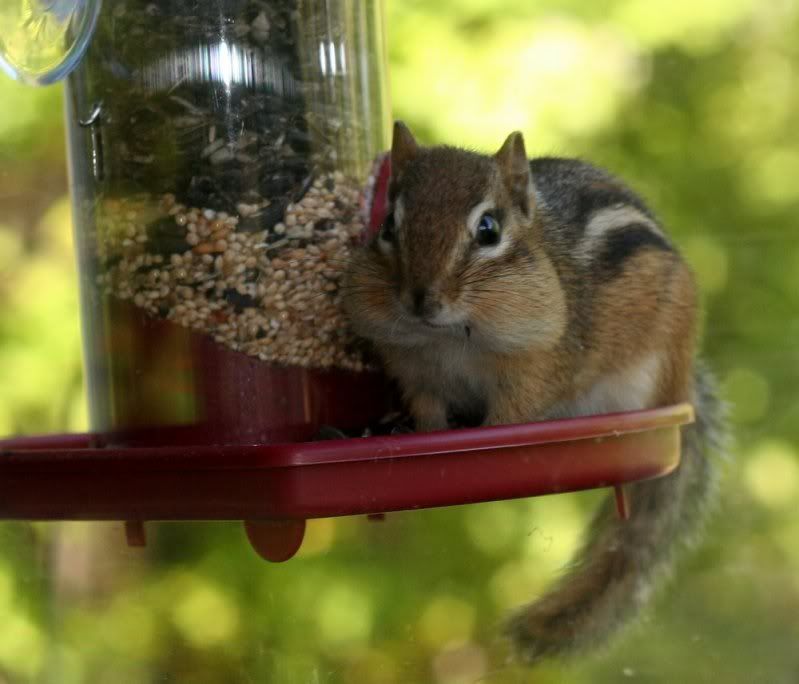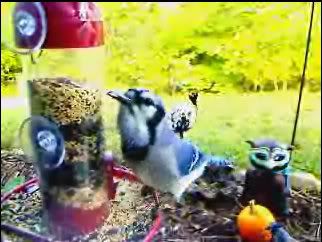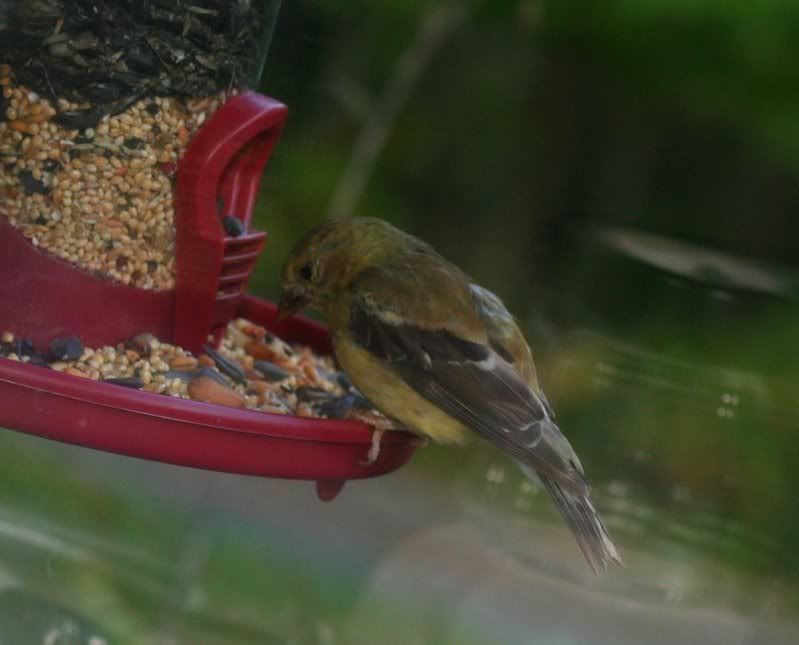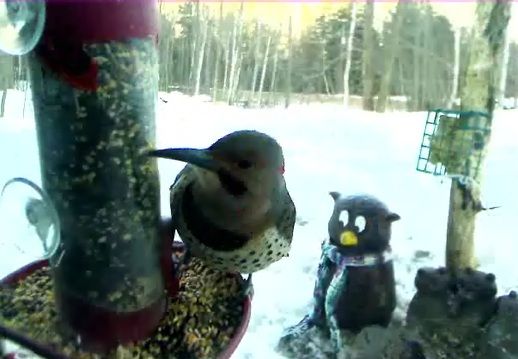Below is a breakdown of what you might see at the cam (both Nova Hummers and WinterBirds). Also, clicking the links in each description will take you to a full profile of each of the animals!
 Scramble - Red Squirrel
Scramble - Red Squirrel Although squirrels are very common in Nova Scotia, we didn't really any at our home until one September day in 2012. That's when this fellow abruptly showed up! He made his presence known by scurrying all over the back deck, and then later on startling me by climbing up the screen on our back door! I affectionately named him Scramble (Scram) and he's been creating lots of entertainment on the Cam ever since! He's one of the more frequent visitors!
Unlike chipmunks, red squirrels don't hibernate, so he's likely to visit our feeder all winter long!
More on Red Squirrels can be seen here.
 |
| A chipmunk fills his cheek pouches with seeds. |
The stripes are what give away this little guy!
I'm not totally sure how I feel about chipmunks. They're ridiculously cute, but man, can they ever eat a lot of seed! They can stuff their cheecks so full that it looks like they might explode!They clean my feeder out in a matter of hours! I would love to see where they store it all!
 Black-capped Chickadees
Black-capped ChickadeesBluejays
 |
| Bluejay |
 |
| Female Goldfinch |
Another colorful pleasure to have at the feeder! Typically these birds love to eat thistle and sunflower seeds. They have the cutest little chirp, and in the spring they almost allways travel together in pairs. Birds of Nova Scotia says the following, Length: 13-14 cm. Adult male: Crown and tail black; wings black with white bar and yellow lesser coverts; uppertail coverts white; rest of plumage bright canary-yellow. Adult female: Upperparts buff with yellowish tinge; no black crown patch; wings and tail lighter than summer male's; underparts buff washed with pale yellow; two white wing bars."
| Mourning Dove |
These birds are pretty skittish and generally graze on the grass below the feeder.
Mourning doves are very vocal and I often hear them from inside my house. Their song or "cooing" is almost haunting!
Unfortunately for the Mourning Doves that visit our lawn, they have to be especially weary of our dog, Rufus. Mourning Doves were once game birds, and my dog really wishes that were still the case. Although he never has caught one, he does his best at trying.
For more on the Mourning dove, Click here.
 |
| A group of Juncos socialize and graze |
These small birds are very common at the feeder. These steel grey, white- tummied birds are similar in size and shape as chickadee's. They are quite cute and chirp happy little "peep peep's" as they eat.
Typically, they arrive in groups (or flocks?) and dwaddle around for an extended period of time. They won't usually come right up to the feeder, and usually prefer to collect small seeds on the ground. You can usually see them in the background.
Additionally, Birds of Nova Scotia describes them in the following manner, 'This is one of our most common and best known birds. To some it is known as the "black snow-bird"; because of its slaty plumage, others miscall it a "bluebird." "
Northern Flicker
Northern Flickers rarely visit feeders. Typically they can be found pecking at the ground, searching for tasty insects. Occasionally they will visit a suet basket. This fellow was investigating the seed feeder, which caught me by surprise!
Flickers are part of the woodpecker family (as you can tell by their long beak). In Nova Scotia they are very common in the summer, but less common in the winter. They are beautiful, medium sized birds. Birds of Nova Scotia describes them as follows, "Length: 30-33 cm. Adult male: Crown ashy gray with red bar across nape; back grayish brown with broken bars of black; rump white; undersurface of wings and tail brilliant yellow; throat and face cinnamon; short, black "moustache" mark extending down from gape; underparts light fawn, boldly marked with round black spots; black crescent-shaped band across breast. Adult female: The same but she lacks the black facial mark below the cheek. "
 |
| Juvinile Ruby-Throated Hummingbird. |
By far the biggest star of the Cam, the Ruby throated hummingbird is a joy to watch.
Hummingbirds, unlike the "Winter Birds" are only seasonal occupants here. Typically, they arrive in early May and then leave in September.
These tiny little fellows are described as, "Length: 7.5-9.5 cm. Adult male: Top of head and back bright glossy green; tail dark grayish brown and forked. Throat patch iridescent, showing coal-black at one moment and ruby-red the next; breast whitish, sides dark with greenish tinge. Bill long and needle-like. Adult female: Upperparts similar to male, but outer ends of her feathers are beautifully and broadly tipped with satiny white, and tail is not forked. Underparts whitish with no throat patch" (Birds of Nova Scotia).
The antics of hummingbirds are something that never gets boring. Despite their size, and beauty, they are very territorial and will bicker and chase one another from the feeder. They'll also dive-bomb anyone who dare to wear red in our yard!

where good place for pic taking of lot birds in close to Windsor ns??
ReplyDelete